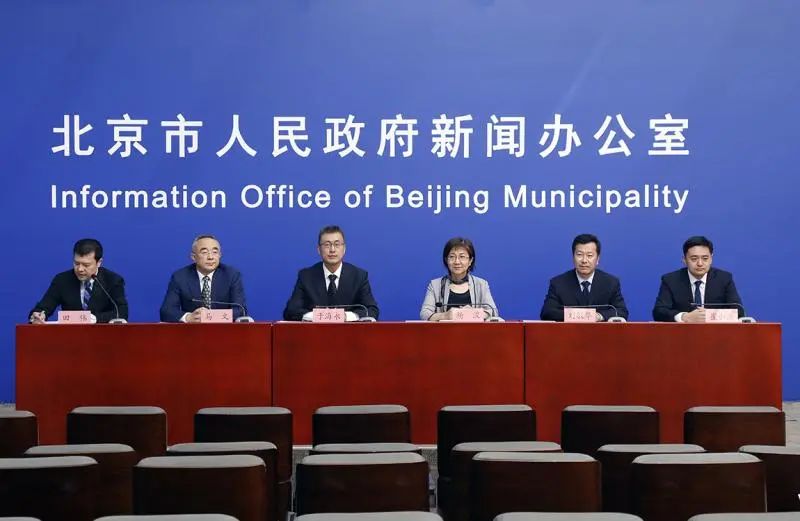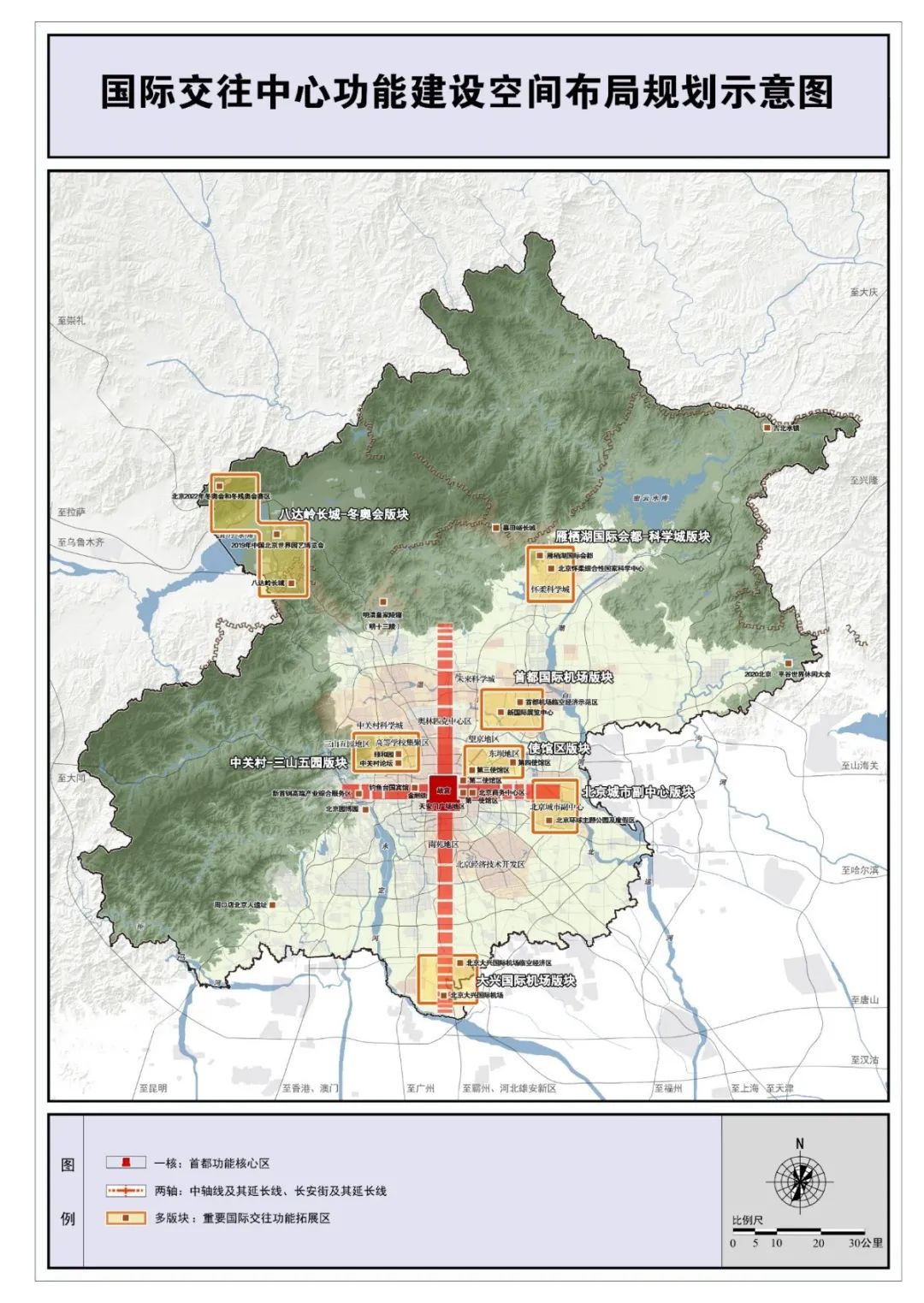On the morning of September 27, the Information Office of Beijing Municipality held a press conference on improving Beijing's role as the center for international exchanges. The first-ever Specialized Plan for Strengthening Beijing's Role as the Center for International Exchanges was released, which is a result of Beijing's accelerated efforts to improve top-level design. The plan puts forth a spatial layout of “one core, two axes and multiple sections” and maps out a blueprint for the building of a center for international exchanges in the coming 15 years.

Goals set for the coming 15 years
Yang Jun, Deputy Director-General of Beijing Municipal Commission of Planning and Natural Resources, said that the plan was developed by the commission together with the Foreign Affairs Office of the People's Government of Beijing Municipality. The plan sets the goals for improving Beijing's role as the center for international exchanges, which is in alignment with China's “Two Centenary Goals”. By 2035, Beijing will become a primary stage for major diplomatic events in China, a world-leading hub for sci-tech innovation and cooperation, an important window that demonstrates China's cultural confidence, inclusiveness and charm, and a center for international exchanges that reflects China's strengths in global governance.

Spatial plan for strengthening Beijing's role as the center for international exchanges
“One core” – core functional area
A primary area for government and diplomatic activities
On the basis of the strategic tasks and development goals, the plan coordinates the needs for international exchanges in various fields and puts forth a spatial layout of “one core, two axes and multiple sections” to improve the functional system and open up new horizon for international exchanges.
“One core” refers to the core functional area for government and diplomatic activities, which serves as an important window to demonstrate the image of the capital city. The plan highlights the central role of Tian'anmen Square and the dominant position of the two axes in the core area and pushes for the nomination of the Central Axis for inscription on the World Heritage List. The Central Axis is intended to demonstrate the charm of the traditional culture and modern civilization, while the Chang'an Avenue conveys the solemn, stately and magnificent national image.
“Two axes” – the Central Axis and the Chang'an Avenue plus their extensions
The “two axes,” namely the Central Axis and the Chang'an Avenue and their extensions, is the area where most international exchanges occur in political, economic and cultural aspects. It is a typical area that demonstrates China's cultural confidence and the image of the capital city.
Central Axis and its extensions: the spatial order of the Central Axis will be improved to fully demonstrate the essence of traditional Chinese culture. The northern extension will display the charm of the modern civilization and ecological progress, with the focus on improving functions such as international conventions and exhibitions, international financial management, and international sports and cultural exchanges, so as to create a high-quality urban environment. The southern extension will feature a traditional-to-modern spatial sequence with international elements, an area equipped with world-class cultural facilities, and a proposed national monument, with functions for international conventions, international cultural expos, international organizations, and so forth.
Chang'an Avenue and its extensions: Chang'an Avenue is designed to be “the principal avenue in China” that signifies the great rejuvenation of the Chinese nation. Leveraging its traditional advantages in international exchanges, the eastern extension will be a key link connecting international cultural resources and an important hub for China's further opening-up and participation in global governance. Coordinated development of functional areas along the western extension will be strengthened to fulfill the functions for comprehensive services and international cultural and sports exchanges. New Shougang Park, a high-end comprehensive service area, will accommodate high-level international sports events and demonstrate the distinct cultural charm of modern industrial heritage.
“Multiple sections” – eastern, western, southern and northern areas
Key areas for public and people-to-people diplomacy
The “multiple sections” serve as key areas for public and people-to-people diplomacy and bright spots that demonstrate the appeal of Beijing as a metropolis in an all-around way.
Eastern area
The eastern area is home to an abundance of high-end international resources. Leveraging this advantage, we aim to build it into a key area for extensive and dynamic international exchanges that fully demonstrates the image of the capital city.
Embassy zones: we will improve the environment of the second and third embassy zones and plan and build the fourth zone up to high standard to spur the upgrade of urban functions in surrounding areas.
Beijing Capital International Airport: we will advance the construction of the New China International Exhibition Center Phase II and III and comprehensively improve the carrying capacity of convention and exhibition facilities and the service capabilities.
Beijing's Municipal Administrative Center: we will set aside dedicated space for international exchanges and actively bring in high-end international resources.
Northern area
The northern area boasts a beautiful natural scenery, great environment and distinct cultural features and will be developed into a new platform for high-level international exchanges.
Yanqi Lake International Conference Resort – Huairou Science City: the Yanqi Lake International Conference Resort will be a core area for state-level international exchanges and diplomatic events. Together with the Huairou Science City, it will be an important stage serving international exchanges and international cultural and sci-tech communications.
Badaling Great Wall – Olympic Winter Games facilities – International Horticultural Exhibition facilities: we will coordinate the facilities and cultural legacy of the Beijing 2022 Olympic and Paralympic Winter Games and 2019 Beijing International Horticultural Exhibition to build international cultural tourism resorts with distinct sports and cultural features and great ecological advantages.
Western area
The western area is home to a host of classic imperial gardens represented by the Summer Palace, a world cultural heritage site and a number of prestigious universities and research institutes. Leveraging these resources, we aim to build the western area into a key area for international exchanges that features the blend of traditional culture and modern culture and is imbued with innovation and vitality.
Zhongguancun – “Three Hills and Five Gardens”: we will vigorously preserve and carry forward the traditional culture in the area of “Three Hills and Five Gardens”. We will exploit the advantage of abundant intellectual resources and create an enabling platform to attract high-level international professionals to innovate or start businesses in Zhongguancun Science City.
Southern area
We will strive to build the Beijing Daxing International Airport area into an emerging key area for international exchanges along the southern extension of the Central Axis. We will tap into the value of historical and cultural resources like the Peking Man Site at Zhoukoudian and the Site of the Yan State Capital of the Western Zhou Dynasty to build a select international tourist area with rich functions.
Beijing Daxing International Airport: in combination with the building of the convention and exhibition center, conference center and business offices, leisure and other functional zones, this area will serve international business and financial activities and international organizations.
Three-year action plan specifying the tasks, timetable and roadmap
The Specialized Plan stresses that the city will strengthen the development of public service facilities in communities for foreign talents, education, healthcare, epidemic prevention and quarantine, and other fields, enhance public health emergency response capabilities in an all-round manner, and build an efficient and convenient transportation network. It will focus on building six functional platforms such as those supporting major state events and attracting high-end international resources, improve the organizational and leadership systems and strengthen institutional building for policy innovation and basic support.
In addition to the plan, the Three-Year Action Plan for Strengthening Beijing's Role as the Center for International Exchanges (2019-2022) was also released, specifying 48 hard infrastructure projects and 30 soft infrastructure tasks as well as the timetable and roadmap.
(Photo in courtesy of: Foreign Affairs Office of the People's Government of Beijing Municipality)


